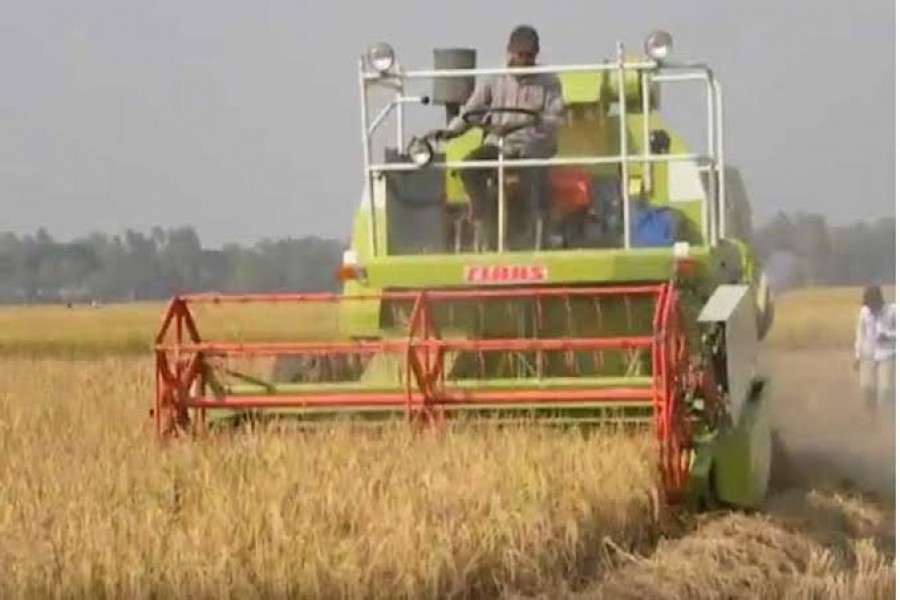The transformation of the country's agricultural sector, in terms of its mechanisation, has been slow but steady.
There is no denying that the mechanisation of Bangladesh agriculture is yet to achieve the level seen in most developed and a number of developing countries. But in some particular areas of farm practices, the pace of mechanisation has been at a fast pace. Land tilling is one such area. Farmers prefer tilling their land with power tillers and tractors. However, the power tiller is the most preferred machine for convenience's sake.
Farmers' love for power tillers is not without reasons. The primary reason for their opting for power tillers is the scarcity of draft animals. And the second one is the soaring wages of farm labourers. Moreover, power tillers can cover a large area within a short time at an affordable cost.
Unlike many countries, most families in rural Bangladesh engaged in farming do not have their own power tillers or other farm machines and they do depend on commercial suppliers for doing the job.
The availability of farm machinery has been growing fast following commercialisation of farm practices. Machines are available on hire for land tilling as well as harvesting of crops.
Some rich rural people have found farm mechanisation as a good source of making money. Small and marginal farmers do not have the resources to buy farm machineries such as power tillers and harvesters. They usually engage these machines on rental basis from an emerging group of rural people who are, in fact, behind the fast mechanisation of agriculture in the country. For long, they have been renting out irrigation pumps and deep tube-wells.
Power tillers are now the most widely used farm machines that are mainly imported from China and India. However, mechanisation is taking its toll on rural employment. It has been responsible for making quite a big number of farm workers unemployed. There has not been any study on the issue until now.
But the fact remains that without these machines farming would have been impossible in the country, mainly because of the scarcity of draft animals.
The situation on the ground suggests that mechanisation of farming is an inevitable development. Without mechanisation, the contribution of the agriculture sector to the country's gross domestic product (GDP) would shrink further. It has already contributed a great deal to a threefold increase in food production during the last four decades or so.
So, efforts on the part of the government should be to make available farm machinery to farmers at an affordable cost. Since these machines are expensive, a section of the rural rich is exploiting small and marginal farmers.
A few of the farm machinery are being manufactured in a number of northern districts, including Bogura and their costs are reasonable. But the imported varieties are still costly and the majority of farmers cannot afford those.
Seeing the marketing prospects, the Bangladesh Steel and Engineering Corporation (BSEC) is reportedly planning to build a power tiller manufacturing plant in the country. The Corporation has sent the development project proposal to its parent ministry on the basis of a feasibility study. The estimated cost of the project is Tk 5.0 billion
This is, no doubt, a good move. Locally manufactured power tillers should cost far less than that of the imported ones. Hopefully, the project would get a green signal from all the relevant government agencies, including the Planning Commission.
Not just power tillers, there should be a move to encourage the private sector to be involved with manufacturing of other agricultural machines. The entrants in this field should get due incentives.
Besides, the government must do something to save small and marginal farmers who are being exploited by the rural groups that are renting out farm machinery.
Formation of cooperative societies with small and marginal farmers would have been the best option. But the cooperative movement has lost its appeal in rural areas for a variety of reasons, including financial irregularities. Revival of the movement, especially for the purpose of purchase, operation and maintenance of farm machinery is necessary. The government might consider providing these machines to such societies at subsidised costs.
Some people in the government's policymaking might find investment in the agriculture sector not very rewarding, these days. The declining contribution of the sector to the national GDP might be the reason for developing such an attitude. But the fact remains that the sector is still feeding the entire population and it is still the largest provider of jobs.
The situation, however, might deteriorate further in the future as the country, according to an estimate, has been losing 1.0 per cent of its arable land every year while accommodating housing and other infrastructural needs. The rate of decline has stirred up worries among top policymakers, but the process of decline, it seems, would continue.


